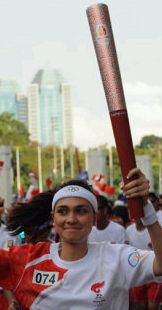Olympic torch built with PCs in mind

KUALA LUMPUR--As the Olympic torch traversed through the Malaysian city this week, scores of people lined the streets to catch a glimpse of the flame that represents the unity and the goodwill of the Beijing Games.
Unbeknownst perhaps to many, the torch was designed by PC maker Lenovo, relying on the same processes the company uses to manufacture its laptop and PCs. The torch was sculptured to represent the history and culture of the country and city that is hosting this year's Games.
 An Olympic torchbearer =small>(source: Beijing Torch Relay) |
According to Yao Yingjia, vice president and general manager of Lenovo Innovation Design Center, the company employed the same considerations it undertakes when making its PCs and laptops.
These requirements include several parameters such as size, weight, security features and material to protect the torch when dropped, explained Yao, who is based in Beijing, China.
"This is 'the Lenovo way'--to first explore the connection between the human being and the product we create," he told ZDNet Asia in an e-mail interview. "Following that, we encourage our design team to take a fresh approach to make the product unique and friendly to the customer."
Likening the torchbearer to a Lenovo PC customer, Yao revealed that the team began by asking itself what it would take to allow the torch to stand out from previous Olympic torches.
"[These questions included] what would make holding this torch more memorable? What would the torchbearer like to experience when holding it?" he said. "We did this to come up with the best consumer experience."
"We realized that the torch must be attractive to those who see it, and at the same time, comfortable and light for those who carry it," he added.
With these questions in mind, the team designed the torch made of exceptionally lightweight material--an aluminum-magnesium alloy--making it the second lightest Olympic torch ever to be built, Yao said.
He noted that the team also did not want the torchbearer's hands to feel the cold metal piece when carrying the torch.
"So we experimented with red paint that coats the handle of the torch, and decided that by combining the paint with liquid rubber, we would create a torch handle that felt warm and soft, like one hand holding another," Yao explained.
The final design produced a torch that was constructed from polished aluminum-magnesium alloy, and measures 720mm (millimeters) by 50mm by 40mm. Weighing just 1 kilogram, it is designed to remain lit for at least 25 minutes.
Lenovo's Olympic design group was a 40-strong team, consisting of 10 core members and 30 support crew, who worked for more than 10 months to create the torch. The team consisted of various professionals with expertise spanning graphic design, chemistry, engineering, materials, anthropology, art and history.
The Olympic Torch Relay entered its Malaysian leg Monday afternoon at Dataran Merdeka (Independence Square), culminating at the Kuala Lumpur City Centre in the evening.
Lenovo is also the hardware supplier for the Beijing Olympic Games, and is expected to provide over 14,000 units of equipment including desktops, laptops, printers and servers.
Edwin Yapp is a freelance IT writer in Malaysia.